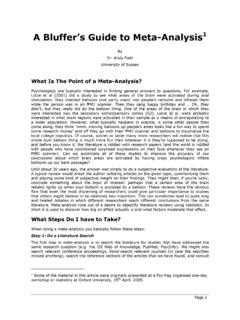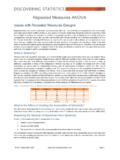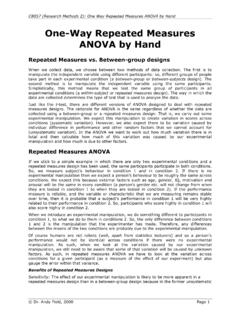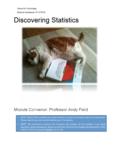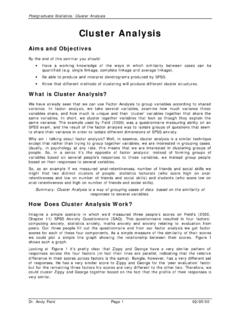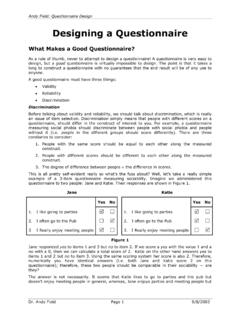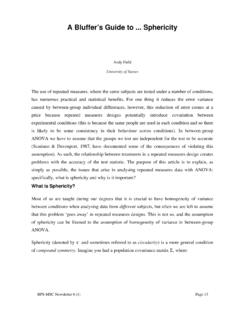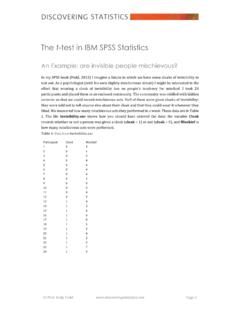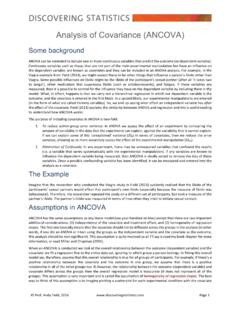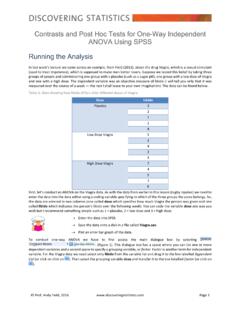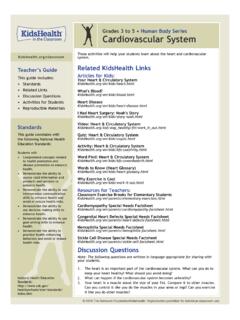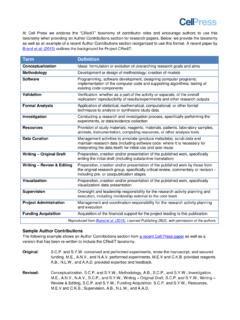Transcription of © Prof. Andy Field, 2016 www.discoveringstatistics.com Page 1
1 Prof. Andy Field, 2016 Page 1 Writing Up Research This following provides a brief overview of the structure and content of various elements in a laboratory report, based on APA guidelines. The APA publication manual should be referred to for more detail (American Pyschological Association, 2010). The purpose of a lab report is to communicate research in a clear, systematic and standardised way. Primarily, a lab report should communicate the following things: Why did I bother? Why did I do this research and why is it an interesting contribution to science? How did I do it? How did I carry out this research (this should be detailed enough so that the study could be replicated precisely)? What did I find?
2 What were the results of your study? So What? What do your findings mean in terms of your hypotheses and what theoretical contribution do they make? Snail of Sense! The advice that we give you in this handout is not inflexible, it is a guide. For example, when we say that the title should be fewer than 12 words, the world will not end if your title is 13 words. So, please use your common sense. In case you do not have any, the snail of sense will appear to give you some advice. Format of a Laboratory Report There are several sections to a lab report: Title Abstract Introduction Method o Participants o Materials (Optional) o Design (Optional) o Procedure o Scoring (Optional) Results Discussion References Appendix (Optional) Title The APA recommends that titles should be no more than 12 words.
3 Prof. Andy Field, 2016 Page 2 A good title alerts the reader to the overarching theme of the work to be reported. A good title also captures the reader's attention. But the latter goal should not interfere with the former one. Do not use superfluous words or abbreviations: for example, why write An Empirical Investigation into Anxiety Disorders in Children with .. , when you could write Anxiety Disorders in Children with .. ? Too Vague: The Beer-Goggles effect Too specific: Investigation into the effects of drinking 6 pints of Guinness in a nightclub in Brighton at , while listening to drum and bass played at 100 db through a good sound system, on 12 men s and 15 women s ability to accurately judge the attractiveness of members of the opposite sex About Right: Beer-Goggles : Do alcohol and lighting influence attractiveness ratings of the opposite gender APey-Ape: Titles The APey Ape is a stickler for APA style.
4 He will pop up to tell you what it says in the APA publication manual. A title should summarize the main idea of the manuscript simply and with style. It should be a concise statement of the main topic and should identify the variables or theoretical issues under investigation. Abstract What is the study all about (in no more than about 150-250 words). Abstracts provide a reader with the most important details. Ideally, the abstract enables the reader to decide whether he or she should read the article. Again, never promise more than can be given. Not everyone is going to be interested in the work; but that does not mean the writer should not point out some of the most intriguing features of the study. The abstract should not be composed of selected sentences from the body of the paper.
5 Instead, the writer should sit down and try to distil the essential elements of the work to be reported. The abstract is extremely important; it should not be short-changed. It should be written last. This paragraph should concisely describe the problem under investigation and the motivation for the study, the participants, the experimental method, findings, and conclusions. You could try to write a sentence on each of these areas. To conserve characters in the abstract, type all numbers except those that begin a sentence as digits. Avoid ending the abstract with throw-away and uninformative statements such as These results will be discussed , or how these results relate to past theory will be discussed.
6 Ugly (1993) has shown that the propensity to misclassify members of the opposite sex as attractive is increased in nightclub settings. This study was designed to ascertain whether this effect is due to the dim lighting employed in these venues, or the consumption of alcohol in this setting. Ratings of the attractiveness of a set of stooge participants were taken in both a well-lit and dimly-lit nightclub by both sober and drunk participants. A 2-way ANOVA revealed a significant effect of alcohol consumption, but not of the lighting used. The results suggest that, contrary to Ugly s hypothesis, dim lighting does not contribute to the inflated attractiveness of opposite-gender mates; instead these ratings are influenced solely by alcohol intake.
7 Prof. Andy Field, 2016 Page 3 APey-Ape: Abstract A good abstract is: Accurate: it should convey the purpose and content of the study accurately. It should cover the main areas of the report ( , rationale, methods, results, implications). Nonevaluative: report what is in the manuscript; do not evaluate it. Coherent and readable: use verbs rather than nouns, use the active rather than the passive voice, use the past tense to describe what was done, but the present tense to describe results or conclusions drawn. Concise: be brief and avoid superfluous statements/words. Word limits vary from journal to journal and typically range from 150 to 250 words. Introduction A good introduction addresses two questions: What has been done in this area by other researchers?
8 What is the point of the present study? APey-Ape: Abstract An introduction should answer these questions in a few pages: Why is this problem important? How does this study relate to previous work in the area? What are the primary and secondary hypotheses and objectives of the study? How do the hypotheses and research design relate to one another? What are the theoretical and practical implications of the study? This section should not get a primary heading ( , "Introduction"), you simply re-write the title at the top of the page. You can use sub-headings in the introduction if it will help the reader. The introduction is the place to include the review of the research literature that led to your hypothesis. For instance, you might show how prior findings are inconsistent or ambiguous.
9 Explain how your research may clarify the problem. State your hypothesis explicitly toward the end of the introduction, after you have explained the research and thinking that led to it. Identify independent and dependent variables here: Do this subtly, do not write things like The independent variable was amount of alcohol drunk and the dependent variable was the attractiveness of the mate selected, but instead say something like this study looks at whether the amount of alcohol drunk and the gender of the consumer has an effect on the attractiveness of the mate selected. If you have made predictions about the outcome of the study, say so ( alcohol is expected to reduce the attractiveness of the selected mate ).
10 Be sure you say why you expect these results. Do not expect readers to guess what you are thinking. In the introduction, you are moving from the general to the specific: A general discussion of the problem area, to your specific hypothesis. Successive paragraphs should be explicitly connected and form the thread of a coherent argument. If we take the beer-goggles example, a good broad structure would be: Define the beer-goggles effect and why it is important. Describe relevant previous research and what it has told us about the beer-goggles effect. This could include theories of the beer-goggles effect. Prof. Andy Field, 2016 Page 4 Describe the problems with previous research and/or explain any unresolved issues within the literature.
